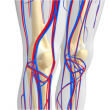Chronic total occlusion (CTO) affect up to 20% of patients undergoing angiographic diagnostic tests. During the last two decades, recanalization technique refinement, the development of specific devices and operator skill improvement have elevated procedural success rate up to 90%. However, there are still particular complications such as collateral perforation and access site complications. This is<a href="https://solaci.org/en/2024/04/25/ercto-registry-chronic-total-occlusion-treatment-outcomes/" title="Read more" >...</a>
Interventional cardiology: the most read articles of 2022 in solaci.org
Discover the most read scientific articles on interventional cardiology of 2022 in our website. The FDA Approves Intravascular Lithotripsy for Calcified Lesions The US Food and Drug Administration (FDA) has cleared the shockwave lithotripsy system to treat severely calcified plaque lesions. Is Epinephrine Superior to Adenosine in No-REFLOW? In patients with acute coronary syndrome, no-reflow prevalence is 32%. Different drugs—such as adenosine, verapamil,<a href="https://solaci.org/en/2023/01/05/interventional-cardiology-the-most-read-articles-of-2022-in-solaci-org/" title="Read more" >...</a>
SOLACI Peripheral | Clinical Case Discussion
SOLACI’s Department of Peripheral Endovascular Interventions is promoting the analysis of challenging clinical cases on peripheral interventions so as to foster the participation and engagement of all SOLACI members. In this first issue, we present a clinical case around carotid artery stenting. Read thoroughly the case below and take part in an unrestricted discussion through<a href="https://solaci.org/en/2020/06/17/solaci-peripheral-clinical-case-discussion/" title="Read more" >...</a>
Consensus on How to Conduct Follow-Up in Peripheral Vascular Disease
Peripheral vascular disease involves multiple areas and, therefore, can have very different presentations (from complete lack of symptoms to disabling symptoms). Depending on clinical presentation, general condition, anatomical localization, and lesion extension, revascularization can be indicated alongside optimal medical treatment. In 2017, guidelines with indications for revascularization were published; however, maintaining long-term patency can be<a href="https://solaci.org/en/2019/12/27/consensus-on-how-to-conduct-follow-up-in-peripheral-vascular-disease/" title="Read more" >...</a>
What is the effect of statins on amputations, and survival in peripheral vascular disease?
The prevalence of peripheral arterial disease is between 15% and 20% of patients older than 65 years and its severity is greatly underestimated. In fact, annual mortality is higher in patients with peripheral arterial disease (8.2%) than in those after acute myocardial infarction (6.3%). Despite the above, medical advice and efforts to modify risk factors<a href="https://solaci.org/en/2018/02/26/what-is-the-effect-of-statins-on-amputations-and-survival-in-peripheral-vascular-disease/" title="Read more" >...</a>
7 articles on angioplasty that can draw your attention
1) Balloon Angioplasty: A Reasonable Plan B for Chronic Thromboembolic Hypertension Thromboembolic pulmonary hypertension is caused by pulmonary artery stenosis caused by organized thrombi. The only treatment potentially healing for this disease is surgical thrombectomy. However, patients with lesions in very peripheral branches or high surgical risk patients with comorbidities might benefit from a plan B,<a href="https://solaci.org/en/2017/11/27/7-articles-on-angioplasty-that-can-draw-your-attention/" title="Read more" >...</a>
Latest articles about peripheral vascular diseases
1) Efficacy of Micromesh-Covered Stents in Carotid Artery Stenting Most literature, old and recent, associates carotid artery stenting with a higher rate of stroke (although minor) when compared with carotid endarterectomy during the acute period. However, 30-day outcomes of angioplasty and surgery are comparable. Read more 2) Multivessel Disease and Severe Carotid Stenosis: How to Proceed Myocardial revascularization surgery (CABG) is<a href="https://solaci.org/en/2017/11/22/latest-articles-about-peripheral-vascular-diseases/" title="Read more" >...</a>
Early Coronary Angiography in High-Risk Non-ST-Elevation ACS
Coronary angiography is essential for patients admitted with non-ST-elevation acute coronary syndrome, since it allows physicians to confirm the diagnosis, stratify the risk, and define the revascularization and antithrombotic management strategies. There is no doubt that these patients should be studied invasively, but the timing for that is still uncertain. Coronary catheterization within<a href="https://solaci.org/en/2017/10/09/early-coronary-angiography-in-high-risk-non-st-elevation-acs/" title="Read more" >...</a>
With Absorb Out, New Resorbable Scaffolds Have Come onto the Market
By restoring vascular physiology and eliminating the inflammatory focus and the chance of fracture and neo atherosclerosis inherent to DES, bioresorbable scaffolds offer the potential to improve long term outcomes. A number of bioresorbable materials have been tested, mainly polylactic acid, with several limitations that have taken the Absorb bioresorbable scaffold out of the market.<a href="https://solaci.org/en/2017/10/09/with-absorb-out-new-resorbable-scaffolds-have-come-onto-the-market/" title="Read more" >...</a>
Frequency and Evolution of Cardiac Perforation in Patients with a History of MRS
Courtesy of Dr. Carlos Fava. Coronary perforation (CP) is a very uncommon event (≈0.4%), associated with severe complications that entail risk of death. It has usually been related to patients with a history of myocardial revascularization surgery (MRS). However, this group usually presents lower rates of cardiac tamponade due to pericardial fibrosis caused by surgery. This<a href="https://solaci.org/en/2017/10/05/frequency-and-evolution-of-cardiac-perforation-in-patients-with-a-history-of-mrs/" title="Read more" >...</a>









